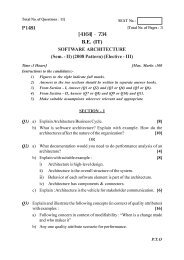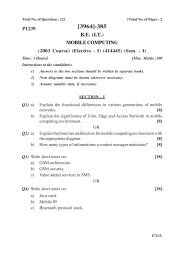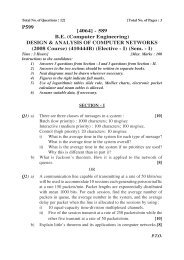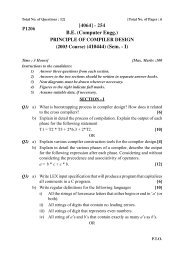Cloud Computing and SOA Convergence in Your Enterprise: A Step ...
Cloud Computing and SOA Convergence in Your Enterprise: A Step ...
Cloud Computing and SOA Convergence in Your Enterprise: A Step ...
You also want an ePaper? Increase the reach of your titles
YUMPU automatically turns print PDFs into web optimized ePapers that Google loves.
Creat<strong>in</strong>g the Governance Model 155<br />
policies def<strong>in</strong>e how a policy is carried out at the lowest level of granularity.<br />
Follow<strong>in</strong>g are examples of micro policies:<br />
Only those from Human Resources can leverage Get_Sal_Info services.<br />
No more than one application, service, or process at a time can access<br />
the Update_Customer_Data service.<br />
The Sales_Amount data element can be updated only by the database<br />
adm<strong>in</strong>istrator, <strong>and</strong> not by the developers.<br />
The response time from the get_customer_credit service must be less<br />
than 0.0001 seconds.<br />
Micro policies are very specific <strong>and</strong> typically dest<strong>in</strong>ed for implementation<br />
with<strong>in</strong> service governance technology that can track <strong>and</strong> implement<br />
these types of policies.<br />
Design Policies<br />
Return<strong>in</strong>g to Figure 8.1, policies are designed like any other part of the architecture.<br />
The purpose of a policy design is to describe the correct behavior for<br />
the service as well as who is allowed access to the service, what they can do<br />
with it, <strong>and</strong> how that access is logged. F<strong>in</strong>ally, a policy def<strong>in</strong>es all other applications,<br />
services, processes, <strong>and</strong> data bound to that service.<br />
While there are design-time governance technologies <strong>and</strong> approaches, as<br />
we discussed <strong>in</strong> Chapter 6, for the most part, you will design your policies us<strong>in</strong>g<br />
st<strong>and</strong>ard office automation technology. However, you will typically implement<br />
your policies by leverag<strong>in</strong>g runtime service governance technology.<br />
You can th<strong>in</strong>k of the design component of policies as the process of def<strong>in</strong><strong>in</strong>g<br />
what the policies will do <strong>and</strong> for what service. Typically, this means<br />
list<strong>in</strong>g th<strong>in</strong>gs that are not allowed, or creat<strong>in</strong>g rules. Once the policies are<br />
well def<strong>in</strong>ed, we implement them us<strong>in</strong>g runtime service governance technology,<br />
which is the <strong>in</strong>tegrated development environment (IDE) <strong>and</strong> the platform<br />
we leverage for policy execution (see Figure 8.5).<br />
Implement Policies<br />
You can consider policies as programs, really. And thus they must be designed,<br />
created, tested, <strong>and</strong> deployed as any program should be. This is the<br />
process of implement<strong>in</strong>g policies, which <strong>in</strong>cludes test<strong>in</strong>g <strong>and</strong> deployment.












